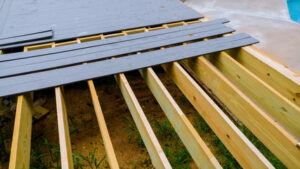Your roof is one of the most important parts of your house. Keeping it in good condition can help to increase your home’s resale value and protect the interior of your home from water damage.

Signs that your roof is nearing the end of its lifespan include granule loss, curling shingles and apparent sunlight entering your attic. These signs are all good reasons to consider a full replacement.
One of the biggest factors influencing the cost of roof replacement is materials. You can choose from a wide range of affordable asphalt shingles, or opt for more expensive metal, clay, or slate. The location of the home also impacts costs, as do labor rates and complexity. In addition to these variables, the pitch of your roof is another significant factor in determining the price. Typically, roofs with a slope of between three (3:12) and six (6:12) degrees will be cheaper to replace than those with steeper angles.
A new roof can add value to your property, if you choose the right contractor. However, it’s important to consider whether the money spent on a new roof will be recouped at the time of sale. Prospective buyers are unlikely to be interested in a home that needs a new roof soon after purchase. A new roof will also help you get a higher sales price and sell your home more quickly.
Many people procrastinate on a roof replacement project, but the longer you wait, the more it will cost. In fact, the cost of roofing is on the rise, due to a variety of factors, including weather conditions and the shortage of qualified contractors. The best way to reduce the risk of high costs is to hire a qualified roofing company.
The best way to save on the cost of a new roof is to have a contractor provide an accurate full scope of work and estimate. You should also ask your roofing contractor to provide a warranty, including workmanship and material warranties. If possible, choose a contractor that is licensed to provide guaranteed workmanship warranties. You can check this by contacting your local licensing agency.
In addition to paying for a new roof, you’ll also need to pay for permits and removal of the existing roof. Some cities require permits for any structural changes to the roof, and they can take weeks to process. You may also have to pay for disposal and cleanup, depending on your municipality’s rules and regulations. It’s important to budget for these additional expenses, as they can increase the total cost of the project by up to 20%.
Time
A new roof can enhance the overall look of your home and improve its value, especially if it has become damaged. It also helps to lower your utility bills and protects your home from costly water damage. However, it can take a long time to complete the process of replacing a roof, depending on several factors. The size of the roof, the roofing materials and the complexity of the structure all play a role in the timeframe required to complete the project.
Generally speaking, the larger the house and the more complex the roof design, the longer it will take to replace the roof. The pitch (angle of the slope) of the roof also plays a part in how long it takes to install. A roof with a steep pitch will require more materials and painstaking labor to install.
Another factor that affects the timeframe of a roof replacement is the weather. If rain is expected during the installation process, your contractor will likely push back the start date until the weather clears up. The crew will then tarp your roof to protect it from moisture and pick up where they left off the next time it’s dry enough to work on.
If you’re thinking about a roof replacement, consider the impact on your insurance rates. Many homeowners are able to save money on their homeowner’s premiums after having a new roof installed. You can ask your insurance agent about this benefit before you make a decision to get a new roof.
The best time to do a roof replacement is in the summer, when there’s a higher chance of sunny, dry weather. If you’re planning on putting your home on the market in the future, this is an excellent way to boost its resale value.
If you have pets, be sure to keep them indoors during the replacement process. Hammering noises and strange people can be upsetting for dogs, cats and other pets. It’s usually easier to bring them to a friend’s house or hire a pet sitter during the process, but if this isn’t possible, be sure to make arrangements to keep them calm and comfortable.
Efficacy
Roof replacement is more than just a repair, it’s an investment in your home’s safety, efficiency, and comfort. A new roof protects your property from weather-related damage and can improve insulation to reduce heating and cooling costs. It also increases your home’s market value and can make it easier to sell if you ever decide to relocate. Moreover, opting for quality roofing materials and a trusted installation contractor will ensure a long-term investment in your home’s integrity.
Appearance
Depending on the style you choose, your roof can completely change the look of your home. You may want to consider this aspect before getting a roof replacement. If you have an HOA, be sure to check their standards on changing the appearance of your home. This may prevent you from breaking any rules and paying a fine later on.
Stains on your ceiling can be a sign of leakage. Also examine the flashing around vents, skylights, and chimneys for cracks.



